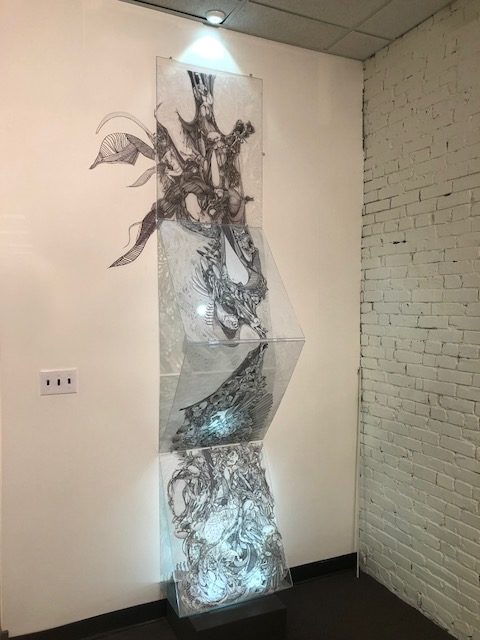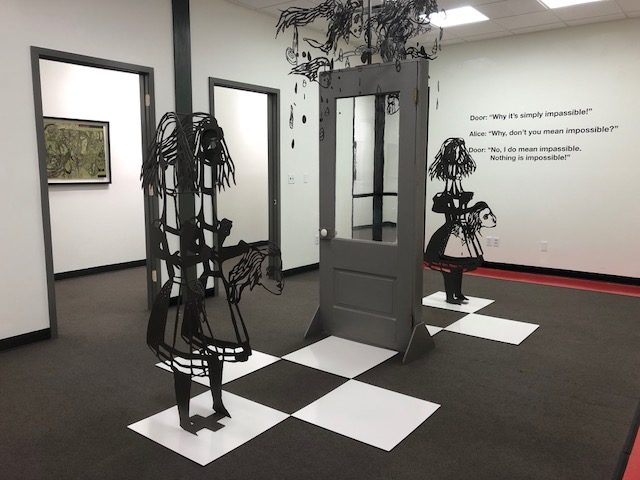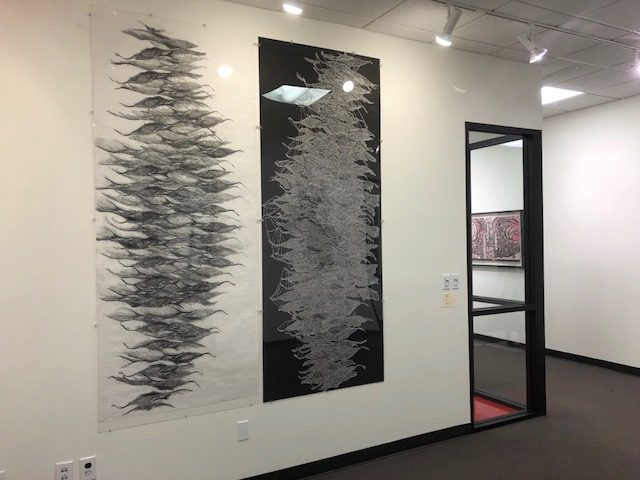Deborah Whistler believes fear should be confronted—and she’s not afraid to use knives. In a showing of her work entitled “Follow the Rabbitâ€at Moremen Gallery in Louisville, Whistler literally dissects the kinds of myths and fairytales that may incite unease. Copies of Alice in Wonderland are delicately sliced, drawings of creatures are finely trimmed, and a gamut of other figures and art historical allusions are collaged and paired. All told, the exhibition stands to interrogate the concept of linearity, and Whistler’s treatment of material generates an aggressive, yet reverent, approach to her subject matter.
The exhibition is stationed in three rooms conjoined by two narrow hallways. Bookending one side is While We Wait (2015), a graphite and cut paper drawing mounted on four hinged pieces of plexiglass whose middle panels jut out from the wall in a convex fashion. Moreover, the work is backlit and remnants of the drawing creep onto the wall. Whistler intricately combines decoratively lacerated paper with lively illustrations of abstract shapes and portraits, some of which are likely to be recognized by viewers, including Caravaggio’s Medusa, Michelangelo’s The Creation of Adam, and selections from Las Meninas by Diego Velázquez.

The physical characteristics of While We Wait become metaphors for the exhibition’s guiding themes. Panels of the hinged drawing hang upside down, and the dramatic sense of movement suggested by Whistler’s mark making, incisions, and placement of shapes and characters make for a whimsical visual experience. Reality has been contorted and twisted; the familiar has become obscured.
These notions continue throughout “Follow the Rabbit.†Whistler is keen in her ability to draw from already eccentric subjects, identifying their unsettling qualities and utilizing them to create dreamlike situations, which are abundant in the exhibition. Whistler’s intention is to embrace the unknown.
It is clear she hopes viewers will too. There are multiple works in “Follow the Rabbit†that call for close scrutiny. Among them, a 2008 rectangular sculpture bearing the exhibition’s title is littered with secret compartments and populated with scenes from Alice in Wonderland, drawn with segmented excerpts from the book that Whistler has deliberately arranged. The drawings that the excerpts create are parallel to the words Whistler has chosen. For example, “Alice opened the door.†appears above a depiction of the curious title character peeking into an entryway.
A copy of the book is opened atop the pedestal—from it spouts a paper chain of the books pages, carved to take the identity of young women. Alice herself has stepped out of Wonderland and entered our world. At the same time, the sculpture’s compartments, often small doors or drawers and may require viewers to bend in order to fully see them, offer breaks from reality. They are filled with mirrors, letterpress blocks, small drawings, and other objects that are capable of distorting or enabling perception.
Together, the text, drawings, and found objects, as well as the sculptural rectangle that holds all of these components, offer inventive ways to reintroduce recognizable material—in this case a well-known piece of literature and the viewer’s own self—as unusual. What’s more, Whistler breaks with expected modes of art consumption by asking the viewer to kneel, squat, and stare into her sculpture.

Life-size versions of Alice are the centerpiece of the exhibition in an installation called Tears of Alice (2010). A doorframe divides the work into two near identical realms, each featuring a steel cast of Alice. The contours of her head and dress are gestural. She appears to hold her decapitated head in her hands, while a head attached to her neck remains faceless. A mobile extending from the doorframe sprinkles illustrative heads, organic swirls, and wisps over the installation. The door contains a large piece of glass so that all details are exposed from any viewing angle. The doorframe and steel casts stand upon a checkerboard pattern formed by wooden slats and the gallery floor.
Tears of Alice reads as a mirror image, wherein the glass in the door can be thought of as reflecting one side of the installation, rather than providing a lens into the other side. However, as the Wonderland tales would have it, the glass functions as both a reflection of the space we occupy and a gateway into a new environment altogether. The door bolsters this kind of reading. Alice—and the viewers near the installation—peer into a separate arena, able to enter if they so choose. Or perhaps they see themselves staring back at them. In either case, Tears of Alice is meant to offer a range of interpretative possibilities through a rather simple presentation of parts, and visitors to the gallery should be unafraid of any that may materialize.

Mirror imaging persists at different moments in the exhibition, such as in Last Breath (2005), a diptych drawing of an abstract composition fabricated from cut paper on the one hand and graphite rubbing on the other. The two versions of the image are not identical, but are similar in shape—an elongated, vertical oval form—and value. Whistler juxtaposes finely chiseled white paper on a black backdrop, and develops a dense graphite drawing on standard paper. They are almost inverses; it is apparent they were made to function as a single work. It is unclear, however, which one would be the negative to the other’s positive.
Perhaps it can be either possibility, or maybe none at all. Whistler creates objects that are not concerned with determinants. Instead, they are grounded in the mystical, or at least Whistler overloads viewers with text, content, line, and materials such that even the most recognizable forms read as incomprehensible. Such is the case in Siren’s Revenge (2018), an eight foot long cut paper drawing on plexiglass that may initially appear entirely abstract, but with close examination features numerous organic forms, human faces, and snakes made using a small blade.
This is surely a thread in “Follow the Rabbit.†Whistler meticulously selects portions from notable works, framing them as unknowable through a combination of collage, drawing, and cutting. She welcomes viewers to learn again, even if it means trekking into the dark.
“Follow the Rabbit†is on view until January 19that Moremen Gallery, located at 710 West Main Street in downtown Louisville.
Â




